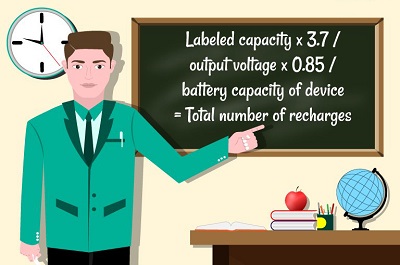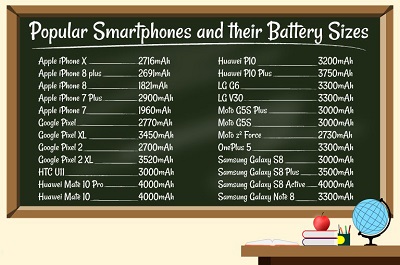移动电源可为手机充多少次?
发布日期:2018-07-26
点击次数:2280
How Many Times Can My Power Bank Recharge a Phone?
.jpg)
We are typically exposed to somewhere between 4000 to 10,000 advertisements per day. Many of these come in the form of packaging – bold claims by manufacturers of the ability and performance specs of their products. For example, your cereal will now often proclaim that it has all your daily essential vitamins and nutrients. In the world of power banks, however, the most often cited indicator used is that of charge capacity – how many times will your power bank charge an external device? But how are these numbers created? Today, we will explore the formula behind charge performance in power banks so that you’re armed with the best possible knowledge base when buying a new product.

The Math
While math may not be the most exciting subject in school (rocket ship designers might disagree), it’s important to understand how exactly a manufacturer calculates the number of times their power bank will charge your cellphone. Here’s the formula they rely on:
(Labeled capacity of the power bank x 3.7 / output voltage of power bank) x 0.85 / battery capacity of device = Total number of recharges
With this in mind, let’s look at this in a couple of examples. First up, the iPhone 8, which has a battery size of 1,821mAh, a little bit smaller than the iPhone 7. Using the above formula we can expect 7.7 recharges of the iPhone 8 from a power bank with a 16000mAh capacity.
(16000 x 3.7 / 5) x 0.85 / 1821 = 5.5 charges
For the Samsung Galaxy S8, we can do the same calculation for its 3000mAh battery:
(16000 x 3.7 / 5) x 0.85 / 3000 = 3.3 charges

The Details
Okay, so we’ve given you a formula, but what does it all mean? Let’s start with the first multiplication number – 3.7. This is the average voltage that you find in a battery cell. Normally you calculate this number by finding the mid-point between a fully charged cell and cell cut off (when it’s empty), and it’s specific but not universal to all lithium-ion batteries. Li-ion batteries featuring cobalt average at about 3.6 while those with manganese hover at 3.7.
How about the next one – 5? We use this here as the average voltage output of a typical power bank. They can often range depending on output type (USB, fast charge, lightning) and internal electronics. Again, you can normally find these details in the product specifications of whatever it is you’re buying. If using the above formula, be sure to swap out the 5 for whatever that devices voltage output is.
After that we have 0.85, which is multiplied by the average output voltage above. 0.85 is the average efficiency of a power bank, meaning that you’ll never get 100% of the total expected output as advertised. This is due to two things. First, because power banks boost output voltage from the average of 3.7 to 5, energy is lost when moving through its circuitry. Adding to that energy is lost as heat during a transfer and within the smartphone itself when moving to the battery; you can expect about 85% efficiency due to wasted and lost voltage. Please note that 0.85% conversion rate varies between chargers.
Specific Recharge Times
Here are some specific recharge times if you haven’t got time to be doing the math. I’ll be using 2 popular capacities, 10,000 mAh and 20,000 mAh.
So a 10,000 mAh power bank fully precharged can fully charge your iPhone:
iPhone 7: (10,000×3.7 / 5) x 0.85 / 1960 mAh = 3.2 recharges
iPhone 8: (10,000×3.7 / 5) x 0.85 / 1,821 mAh = 3.4 recharges
iPhone X: (10,000×3.7 / 5) x 0.85 / 2716 mAh = 2.3 recharges
Galaxy S8: (10,000×3.7 / 5) x 0.85 / 3000 mAh = 2 recharges
Galaxy S9: (10,000×3.7 / 5) x 0.85 / 3000 mAh = 2 recharges
So a 20,000 mAh power bank fully precharged can fully charge your iPhone:
iPhone 7: (20,000×3.7 / 5) x 0.85 / 1960 mAh = 6.4 recharges
iPhone 8: (20,000×3.7 / 5) x 0.85 / 1,821 mAh = 6.8 recharges
iPhone X: (20,000×3.7 / 5) x 0.85 / 2716 mAh = 4.6 recharges
Galaxy S8: (20,000×3.7 / 5) x 0.85 / 3000 mAh = 4 recharges
Galaxy S9: (20,000×3.7 / 5) x 0.85 / 3000 mAh = 4 recharges
Note: These examples also work for devices such as tablets and cameras.
As you can see with the 20,000 mAh power bank, it charges the devices twice as fast as the 10,000 mAh power bank. If you have a new device that uses a large battery, you’re going to need a power bank with a large battery capacity.
Factors that Affect Recharges
Before you find out how many times your device can be charged, you need to know the factors that affect recharges so you can recharge your device as much as possible.
- Using Your Device – If you are using your device for entertainment, e.g. you’re watching a movie on Netflix. It’s going to appear as if your device never actually charged.
Excessive use of your device, while it’s connected to the charger, is going to suck the power out your device. You’re effectively removing the charge on the battery as quickly as you’re charging it.
- Not Using Your Device – Another reason why your recharge time will be different may also be because of how little you’re using it. For example, you’ve left your phone on airplane mode while it’s been charging.
If this is your approach when charging your device, you’re going to get a lot more recharges out of the power bank. This is because the device isn’t using much battery power while it’s being charged.
- Age of the Battery – When using lithium polymer batteries, you need to know that the capacity of the battery also reduces with age.
For example, a 10,000 mAh power bank you bought today may only have a capacity of 8,500 mAh in a years time.
You can slow this process down by storing your power bank in the correct place. A battery that’s stored at high temperatures (such as 30 degrees) is going to deteriorate a lot faster than a power bank stored at a cooler temperature.
This doesn’t mean that you should store your battery in the freezer! Just keep it’s in a cool dry environment or keep it directly away from the sun. This is going to prolong the capacity of your power bank.
- Efficiency of Your Battery – You also need to know that your device may have lost a few capacities over time. If your device is fairly old, (let’s say over 1 year) this would be the case.
When you charge your device to 100%, you may think that your device actually has 100% charge. In reality, your device is actually charged to 80% or 90% but it’ll appear as if it’s charged to 100%. Again, this is due to the condition and the age of the battery.
Conclusion
Ta da! Just like that, you’re equipped with the knowledge and tools needed to see past those attractive marketing lines and find out for yourself the effectiveness of your power bank. The rechargeable battery world is now your oyster. Go out and explore!

